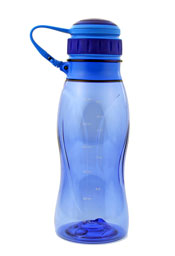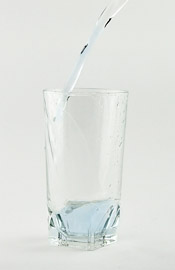Water Filtration at Home
by Shannyn Snyder
 Taking the steps from buying bottled water to bottling your
own can be a relatively simple process with little to no expense or
investment. However, the transition can require a little extra effort for those
consumers who worry about the safety of their home tap water.
Taking the steps from buying bottled water to bottling your
own can be a relatively simple process with little to no expense or
investment. However, the transition can require a little extra effort for those
consumers who worry about the safety of their home tap water.
As mentioned in the "clear choice" article, in his book Plain Talk About Drinking Water, Dr. James M. Symons states that most tap water is indeed safe, although it should be noted that those who live on well water are responsible for determining their own water quality. For those consumers serviced by municipal water, The Consumer Confidence Report (which often arrives with your water bill) typically lists, among other data, which various parasites and chemicals are part of their daily testing and how the water is treated.
 In addition, anyone can test their water for added assurance
that their water is ready for drinking. According to Healthy
Child, Healthy World by Christopher Gavigan, water testing kits such as WaterSafe are typically available at
home improvement stores (p 173) as well as online. Although more expensive
than home testing, homeowners can also have their water tested by a licensed, professional service. Well-water should also be tested annually via one of these options to ensure
its safety for all uses. Should a home test yield adverse results, the U.S.
Environmental Protection Agency has a Safe Drinking Water Hotline
(800-426-4791) for consumers who have questions about water quality or water
safety issues.
In addition, anyone can test their water for added assurance
that their water is ready for drinking. According to Healthy
Child, Healthy World by Christopher Gavigan, water testing kits such as WaterSafe are typically available at
home improvement stores (p 173) as well as online. Although more expensive
than home testing, homeowners can also have their water tested by a licensed, professional service. Well-water should also be tested annually via one of these options to ensure
its safety for all uses. Should a home test yield adverse results, the U.S.
Environmental Protection Agency has a Safe Drinking Water Hotline
(800-426-4791) for consumers who have questions about water quality or water
safety issues.
Gavigan of the Healthy Child, Healthy World organization says that even if water quality reports and testing produce a clean bill of health, consumers who need additional peace of mind can take filtration a step further by adding a home water filter. These filters include faucet or countertop units, whole-house filters or a distiller. However, filtration can be as simple as placing a small filter pitcher, such as by Pur or Brita, in your refrigerator or on your desk. These convenient containers come in a variety of sizes and use activated carbon to absorb sediment and chemicals (pgs 174-176).
Bottled water drinkers who typically purchase the beverages predominantly because of the convenient packaging can invest in a few stainless steel water bottles which can be filled with readied tap water, rinsed and reused. These bottles are easily found on the web or in local department stores, and according to Gavigan, should be chosen in lieu of plastic containers which can contain chemicals that may leach into water over time (pgs 176-177).
Finally, according to the U.S. Geological Survey, available fresh water only accounts for 3% of the worldwide water resources, so conservation is not only responsible but necessary. Concerned consumers can take steps towards conservation by bottling tap water at home. In the long run, a decreased demand for bottled water products may help discourage manufacturers from producing a wasteful commodity that alone accounts for more than 2 million tons of plastic refuse in U.S. landfills today.